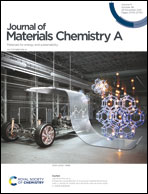In situ forming asymmetric bi-functional gel polymer electrolyte in lithium–sulfur batteries†
Abstract
An asymmetric bi-functional gel polymer electrolyte (GPE) with an interpenetrating network (IPN) has been prepared by in situ cationic polymerization of 1,3-dioxolane (DOL) (PDXL) and cross-linking of cyanoethyl polyvinyl alcohol (PVA-CN), which is initiated by lithium hexafluorophosphate. The mechanism of the Ritter reaction was proposed for the cross-linking of PVA-CN. The IPN-GPE has a high ionic conductivity (3.23 × 10−3 S cm−1 at 25 °C) and high tLi+ (0.81). Li–S batteries with the asymmetric GPE exhibit good cycle stability (807 mA h g−1 after 500 cycles at 0.5C) and high Coulombic efficiency (∼99.6%). Furthermore, the self-discharge of Li–S batteries can be greatly inhibited, and only 6.4% of capacity loss is observed after 24 hours. The improved performance can be ascribed to the bi-functional GPE, i.e. immobilizing soluble Li polysulfides by the carbonyl groups of the IPN-GPE in the cathode side and promoting uniform Li deposition by the PDXL-GPE in the anode side. Our work has provided a meaningful strategy for in situ forming bi-functional GPEs to improve the performance of Li–S batteries.

- This article is part of the themed collection: Journal of Materials Chemistry A HOT Papers


 Please wait while we load your content...
Please wait while we load your content...